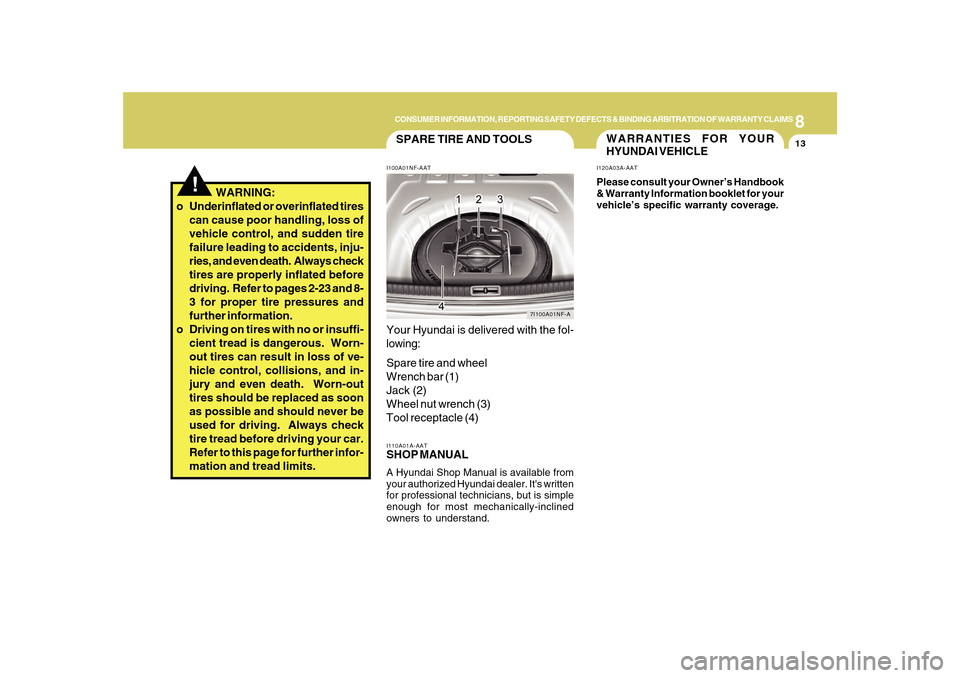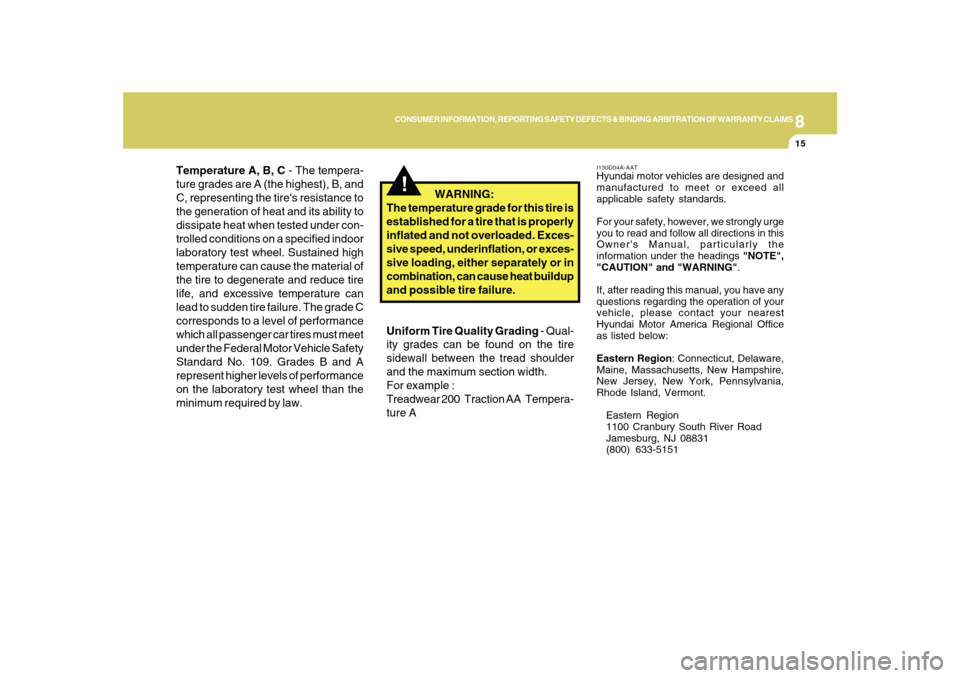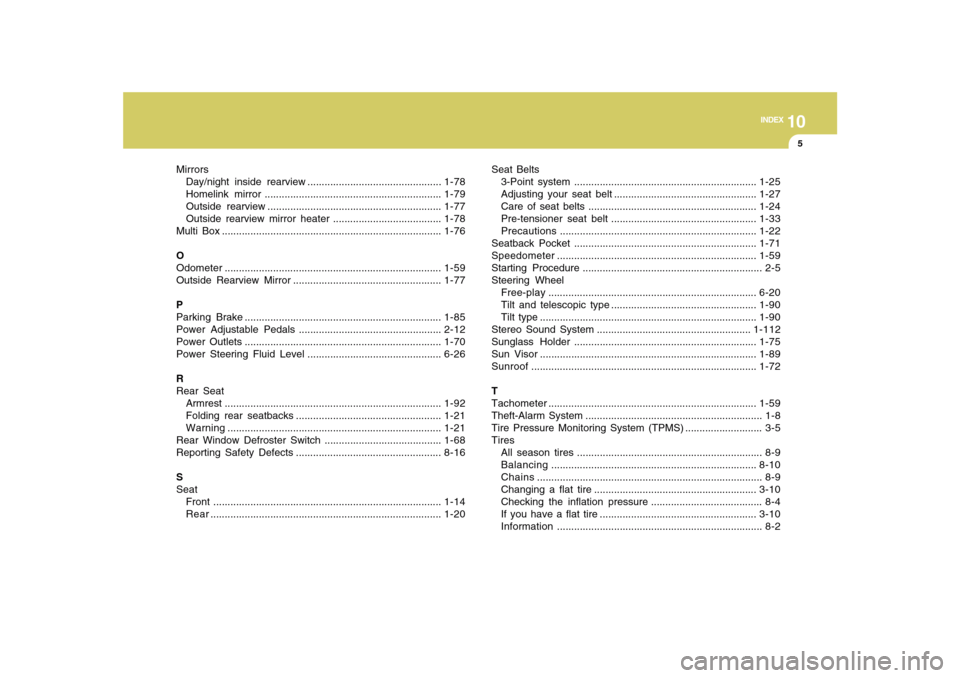2010 Hyundai Sonata flat tire
[x] Cancel search: flat tirePage 267 of 285

8
CONSUMER INFORMATION, REPORTING SAFETY DEFECTS & BINDING ARBITRATION OF WARRANTY CLAIMS
9
Vehicle Capacity Weight: The number
of designated seating positions multi-
plied by 150 lbs. (68 kg) plus the rated
cargo and luggage load.
Vehicle Maximum Load on the Tire:
Load on an individual tire due to curb
and accessory weight plus maximum
occupant and cargo weight.
Vehicle Normal Load on the Tire:
That load on an individual tire that is
determined by distributing to each axle
its share of the curb weight, accessory
weight, and normal occupant weight
and dividing by 2.
Vehicle Placard: A label permanently
attached to a vehicle showing the origi-
nal equipment tire size and recom-
mended inflation pressure.
I050A04Y-AATTIRE CHAINS
Tire chains, if necessary, should be
installed on the front wheels. Be sure
that the chains are the proper size and
that they are installed in accordance
with the manufacturer's instructions.
To minimize tire and chain wear, do not
continue to use tire chains when they
are no longer needed.
I040B01JM-AATALL SEASON TIRES
Hyundai specifies all season tires on
some models to provide good perfor-
mance for use all year round, including
snowy and icy road conditions. All sea-
son tires are identified by ALL SEASON
and/or M+S (Mud and Snow) on the tire
sidewall. Snow tires have better snow
traction than all season tires an may be
more appropriate in some areas.I040A01O-AATSNOW TIRES
If you equip your car with snow tires,
they should be the same size and have
the same load capacity as the original
tires. Snow tires should be installed on
all four wheels; otherwise, poor han-
dling may result.Snow tires should carry 4 psi (28 kPa)
more air pressure than the pressure
recommended for the standard tires on
the tire label on the driver's side of the
center pillar , or up to the maximum
pressure shown on the tire sidewall,
whichever is less.
Do not drive faster than 75 mph (120
km/h) when your car is equipped with
snow tires.
Page 269 of 285

8
CONSUMER INFORMATION, REPORTING SAFETY DEFECTS & BINDING ARBITRATION OF WARRANTY CLAIMS
11
!
WARNING:
To reduce the chance or serious or
fatal injuries from an accident caused
by tire failure or loss of vehicle con-
trol:
o Replace tires that are worn, show
uneven wear, or are damaged.
Worn tires can cause loss of brak-
ing effectiveness, steering con-
trol, and traction.
o Do not drive your vehicle with too
little or too much pressure in your
tires. This can lead to uneven
wear and tire failure.
o When replacing tires, never mix
radial and bias-ply tires on the
same car. You must replace all
tires (including the spare) if mov-
ing from radial to bias-ply tires.
HNF5015 I090A04JM-AAT
WHEN TO REPLACE TIRES
The original tires on your car have tread
wear indicators. The location of tread
wear indicators is shown by the "TWI"
or " " marks, etc. The tread wear
indicators appear when the tread depth
is 0.06 in. (1.6 mm). The tire should be
replaced when these appear as a solid
bar across two or more grooves of the
tread. Always replace your tires with
those of the recommended size. If you
change wheels, the new wheel's rim
width and offset must meet Hyundai
specification.
Tread wear
indicator 0.06 in. (1.6 mm)
I080A01A-AATTIRE TRACTION
Tire traction can be reduced if you drive
on worn tires, tires that are improperly
inflated or on slippery road surfaces.
Tires should be replaced when tread
wear indicators appear. To reduce the
possibility of losing control, slow down
whenever there is rain, snow or ice on
the road.
Page 270 of 285

8CONSUMER INFORMATION, REPORTING SAFETY DEFECTS & BINDING ARBITRATION OF WARRANTY CLAIMS12
!
!
I090B02JM-AATTIRE MAINTENANCE
In addition to proper inflation, correct
wheel alignment helps to decrease tire
wear. If you find a tire is worn unevenly,
have your dealer check the wheel align-
ment.
When you have new tires installed,
make sure they are balanced. This will
increase vehicle ride comfort and tire
life. Additionally, a tire shoud always be
rebalanced if it is removed from the
wheel. o Using tires and wheel other than
the recommended sizes could
cause unusual handling charac-
teristics and poor vehicle control,
resulting in a serious accident.
o Wheels that do not meet Hyundai's
specifications may fit poorly and
result in damage to the vehicle or
unusual handling and poor ve-
hicle control.
o The ABS works by comparing the
speed of the wheels. Tire size can
affect wheel speed. When replac-
ing tires, all 4 tires must use the
same size originally supplied with
the vehicle. Using tires of a differ-
ent size can cause the ABS (Anti-
lock Brake System) and ESC (Elec-
tronic Stability Control) (If In-
stalled) to work irregularly. WARNING: WARNING:
Tires degrade over time, even when
they are not being used. Regardless
of the remaining tread, it is recom-
mended that tires generally be re-
placed after 6 years of normal ser-
vice. Heat caused by hot climates or
frequent high loading conditions can
accelerate the aging process. Fail-
ure to follow this Warning can result
in sudden tire failure, which could
lead to a loss of control and an
accident involving serious injury or
death.
Page 271 of 285

8
CONSUMER INFORMATION, REPORTING SAFETY DEFECTS & BINDING ARBITRATION OF WARRANTY CLAIMS
13
!
SPARE TIRE AND TOOLSI100A01NF-AATYour Hyundai is delivered with the fol-
lowing:
Spare tire and wheel
Wrench bar (1)
Jack (2)
Wheel nut wrench (3)
Tool receptacle (4)
7I100A01NF-A
I110A01A-AAT
SHOP MANUALA Hyundai Shop Manual is available from
your authorized Hyundai dealer. It's written
for professional technicians, but is simple
enough for most mechanically-inclined
owners to understand.
WARNING:
o Underinflated or overinflated tires
can cause poor handling, loss of
vehicle control, and sudden tire
failure leading to accidents, inju-
ries, and even death. Always check
tires are properly inflated before
driving. Refer to pages 2-23 and 8-
3 for proper tire pressures and
further information.
o Driving on tires with no or insuffi-
cient tread is dangerous. Worn-
out tires can result in loss of ve-
hicle control, collisions, and in-
jury and even death. Worn-out
tires should be replaced as soon
as possible and should never be
used for driving. Always check
tire tread before driving your car.
Refer to this page for further infor-
mation and tread limits.
WARRANTIES FOR YOUR
HYUNDAI VEHICLEI120A03A-AATPlease consult your Owner’s Handbook
& Warranty Information booklet for your
vehicle’s specific warranty coverage.
Page 273 of 285

8
CONSUMER INFORMATION, REPORTING SAFETY DEFECTS & BINDING ARBITRATION OF WARRANTY CLAIMS
15
Temperature A, B, C - The tempera-
ture grades are A (the highest), B, and
C, representing the tire's resistance to
the generation of heat and its ability to
dissipate heat when tested under con-
trolled conditions on a specified indoor
laboratory test wheel. Sustained high
temperature can cause the material of
the tire to degenerate and reduce tire
life, and excessive temperature can
lead to sudden tire failure. The grade C
corresponds to a level of performance
which all passenger car tires must meet
under the Federal Motor Vehicle Safety
Standard No. 109. Grades B and A
represent higher levels of performance
on the laboratory test wheel than the
minimum required by law.
!
WARNING:
The temperature grade for this tire is
established for a tire that is properly
inflated and not overloaded. Exces-
sive speed, underinflation, or exces-
sive loading, either separately or in
combination, can cause heat buildup
and possible tire failure.
Uniform Tire Quality Grading - Qual-
ity grades can be found on the tire
sidewall between the tread shoulder
and the maximum section width.
For example :
Treadwear 200 Traction AA Tempera-
ture A
I130D04A-AATHyundai motor vehicles are designed and
manufactured to meet or exceed all
applicable safety standards.
For your safety, however, we strongly urge
you to read and follow all directions in this
Owner's Manual, particularly the
information under the headings "NOTE",
"CAUTION" and "WARNING".
If, after reading this manual, you have any
questions regarding the operation of your
vehicle, please contact your nearest
Hyundai Motor America Regional Office
as listed below:
Eastern Region: Connecticut, Delaware,
Maine, Massachusetts, New Hampshire,
New Jersey, New York, Pennsylvania,
Rhode Island, Vermont.
Eastern Region
1100 Cranbury South River Road
Jamesburg, NJ 08831
(800) 633-5151
Page 277 of 285

9
VEHICLE SPECIFICATIONS2
J010A03NF-AATMEASUREMENTJ060A01NF-AATFUEL SYSTEMJ020A01NF-AATPOWER STEERING
J030A03NF-AATTIRE
in.(mm)
Fuel tank capacity
17.7us.gal (14.7 imp.gal, 67 liter)
18.5 us.gal (15.4 imp.gal, 70 liter)* ITEM
J050A01NF-AATBRAKE
Dual hydraulic with brake booster
Ventilated disc
Disc type
Cable operated on rear wheel Type
Front brake type
Rear brake type
Parking brake
Type
Wheel free play
Rack stroke
Oil pump typeRack and pinion
0 ~ 1.18 in. (0 ~ 30 mm)
5.90 in. (150 mm)
Vane type
2.4L/3.3L
189.9 (4800)
72.0 (1830)
58.0 (1475)
107.4 (2730)
61.61 (1565)
61.02 (1550) Overall length
Overall width
Overall height
Wheel base
Wheel tread
Front
Rear
Inflation Pressure
32PSI (220kPa)
60PSI (420kPa)
Type
Full
TemporarySize
P215/60R16
P215/55R17
T125/80D16
* : if installed
Page 284 of 285

10
INDEX
5
Mirrors
Day/night inside rearview ...............................................1-78
Homelink mirror ..............................................................1-79
Outside rearview .............................................................1-77
Outside rearview mirror heater ......................................1-78
Multi Box .............................................................................1-76
O
Odometer............................................................................1-59
Outside Rearview Mirror ....................................................1-77
P
Parking Brake .....................................................................1-85
Power Adjustable Pedals ..................................................2-12
Power Outlets .....................................................................1-70
Power Steering Fluid Level ...............................................6-26
R
Rear Seat
Armrest ............................................................................1-92
Folding rear seatbacks ...................................................1-21
Warning...........................................................................1-21
Rear Window Defroster Switch .........................................1-68
Reporting Safety Defects ...................................................8-16
S
Seat
Front ................................................................................1-14
Rear.................................................................................1-20Seat Belts
3-Point system ................................................................1-25
Adjusting your seat belt ..................................................1-27
Care of seat belts ...........................................................1-24
Pre-tensioner seat belt ...................................................1-33
Precautions.....................................................................1-22
Seatback Pocket ................................................................1-71
Speedometer......................................................................1-59
Starting Procedure ............................................................... 2-5
Steering Wheel
Free-play.........................................................................6-20
Tilt and telescopic type ...................................................1-90
Tilt type ............................................................................1-90
Stereo Sound System ......................................................1-112
Sunglass Holder ................................................................1-75
Sun Visor ............................................................................1-89
Sunroof...............................................................................1-72
T
Tachometer.........................................................................1-59
Theft-Alarm System .............................................................. 1-8
Tire Pressure Monitoring System (TPMS) ........................... 3-5
Tires
All season tires ................................................................. 8-9
Balancing........................................................................8-10
Chains............................................................................... 8-9
Changing a flat tire .........................................................3-10
Checking the inflation pressure ....................................... 8-4
If you have a flat tire .......................................................3-10
Information........................................................................ 8-2